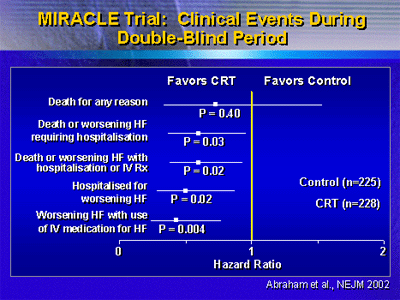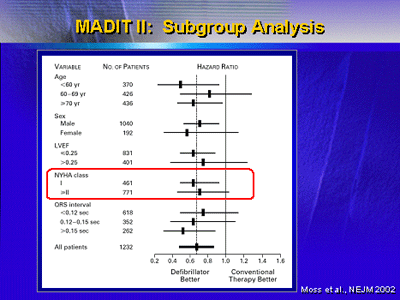Dr. Stevenson
argued that not all patients receiving cardiac resynchronization
therapy (CRT) should also receive an implantable cardioverter
defibrillator (ICD). Patients with ischemic heart failure may
benefit, but studies do not show a primary benefit of the ICD
in the population of patients with nonischemic cardiomyopathy.
Combined CRT and ICD can improve symptoms and decrease arrhythmias.
However, Dr. Stevenson said, the evidence is less convincing
regarding the effect of this combination on disease progression
in all patients.
It is clear that CRT alone offers tremendous functional
improvement in patients with Class III or IV heart failure.
Joint guidelines of the American Heart Association, American
College of Cardiology and the North American Society of Pacing
and Electrophysiology for 2002 reflect this. These guidelines
recommend biventricular pacing for Class III or IV heart failure
patients who have medically refractory symptoms. These patients
should have a QRS duration of at least 130 milliseconds and
a left ventricular ejection fraction of less than or equal
to 35%.
However, not all of these patients should receive both CRT
and an ICD. The proportion of patients who would benefit from
the addition of the ICD is small. Patients with ischemic heart
failure may benefit, but studies do not show a primary benefit
of the ICD in the population of patients with nonischemic
cardiomyopathy. Furthermore, not all patients with ischemic
cardiomyopathy would be eligible for biventricular pacing.
Of those patients, not every one will have a successful implantation.
The benefits of resynchronization therapy are clear. Dr.
Abraham and colleagues illustrated this in the Multicenter
InSync Randomized Clinical Evaluation (MIRACLE) trial. This
study showed an impressive 63% improvement in clinical status
of CRT versus medical therapy. Dr. Abraham believes that adding
an ICD would be logical in this group of patients with stable
biventricular pacing and symptomatic improvement. This may
translate into a mortality benefit.

However, it is debatable whether ICDs are beneficial for
all patients with left ventricular dysfunction or heart failure.
The Multicenter Automatic Defibrillator Implantation Trial-II
(MADIT II) looked at the use of prophylactic ICDs in patients
with left ventricular dysfunction or heart failure. Investigators
reported a 31% reduction in all cause mortality. However,
the absolute mortality rate in this trial was low, suggesting
that many trial participants did not benefit from receiving
an ICD.
Another problem is that published ICD trials include mostly
patients with Class I or II heart failure, and often have
additional risk factors that increase their risk of ischemia.
Perhaps 10% of study participants have had Class III or IV
disease. Therefore, there data supporting the use of ICDs
in patients with Class III or IV disease are not plentiful.
For example, the MADIT II trial excluded Class IV patients,
and a large number of patients had Class I heart failure.

Patients with heart failure due to coronary disease may
feel good and live longer when they receive CRT plus an ICD.
However, this is a small proportion of patients. On the other
hand, researchers do not know much about the benefit of CRT
plus an ICD in the nonischemic population. In the Asymptomatic
Non-sustained Ventricular Tachycardia (AMIOVIRT) trial comparing
amiodarone and ICD, total mortality was the same at 4 years.
Likewise, the Cardiomyopathy Trial (CAT) provided no evidence
that implanting an ICD benefited patients with idiopathic
dilated cardiomyopathy and left ventricular dysfunction.
While AMIOVIRT and CAT are not very large studies, there
is a very large randomized trial underway. The Sudden Cardiac
Death in Heart Failure Trial (SCD-HeFT) compares medical therapy,
medical therapy plus amiodarone and medical therapy plus an
ICD. Enrollment criteria include symptomatic heart failure
due to ischemic or nonischemic cardiomyopathy. To date, investigators
have reported no results from this 2,500 patient trial.
To date, there are no data showing that nonischemic patients
receiving CRT should also receive an ICD. A relatively small
group of patients with ischemic cardiomyopathy will benefit
from the addition of ICD. However, current data do not support
the proposition that an ICD will provide a benefit for all
patients receiving CRT.
|